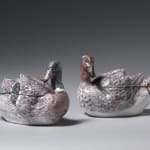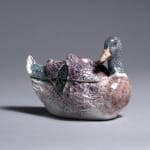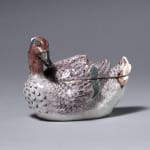


Pair of Bow Duck Boxes and Covers, Circa 1755
Length: 43/8 ins (11.2 cms)
Further images
An extremely rare and highly important pair of Bow Boxes and Covers in the form of a duck and a drake, modelled after engravings by George Edwards. Facing one another in swimming fashion, the upper part of the wings together with the tail, forming the cover and the head and lower part of the body forming the tureen, each head turned to one side to face the viewer in a highly naturalistic way, their bills slightly open, beautifully coloured and ornithologically accurate, the feathers painted in tones of puce through to light browns in a highly detailed manner. The drake’s head and wing tips coloured in a green hue, the duck also having a green band on her head and wings but with the addition of ochre flashes.
These highly naturalistic Bow Duck Boxes and Covers are based on George Edwards’ engraving of “Little Brown and White Ducks” in his book “The Natural History of Uncommon Birds” published in London as a series between the years 1739-51, vol. lll pl. 157. It is also interesting to note that George Edwards (1694 – 1733) was actually born at Stratford in Bow and upon his retirement from the post of Librarian of the Royal College of Physicians in 1764, he moved to Plaistow in Essex. The naturalistic form had been made popular by Kaendler at Meissen during the 1740’s. It was he who embraced the natural influence of the Rococo ideals in Europe which came in turn to influence the modellers and designers at Chelsea under Nicholas Sprimont, who borrowed porcelain from the London home of Sir Charles Hanbury-Williams, the Ambassador to the Court of Augustus the Strong in Saxony, for inspiration and dissemination of new designs. To the same extent this is also true at Bow though it must be noted that this particular factory made a higher proportion of flatware and useful tableware than the naturalistic forms so famous at Chelsea.
Nevertheless, these naturalistic forms were made very successfully at Bow with ranges of leaves, some fruit boxes and covers, partridges and rose boxes. However it must be wholly agreed upon that the most rare and highly successful are the Duck Boxes and Covers which are simply so believable with their level of ornithological details that they become breathtakingly bewitching.
Sadly we do not know the genius designer and modeler who should take credit but the way in which the boxes engage the viewer with their inquisitively friendly faces, transcends the gap from the inanimate to the living.
Of course there has been (as sometimes was) a slight liberty taken with the colouring of the ducks – the colours have been enhanced slightly. This can be noted on a number of particularly female birds when their natural ornithological plumage can be a little dull. In this case the painter has carefully added a green streak to the duck’s head and to its wing tips, thus linking it aesthetically to the drake.
During this period the wild Duck and Teal were prized game quarry and just as it is today, the roast duck was immensely popular as a single course within the eighteenth dinner.
It is highly probably also that these boxes and covers (as we know through our knowledge of the sales at Chelsea, particularly the 1755 catalogue) were sold in pairs and could be used for a rather intimate supper for a very few persons as well as being used upon the table to decorate a larger scene for a greater audience.
As far as cooking was concerned, during the mid eighteenth century, it was a mix between English and French styles – indeed Hannah Glasse’s book “The Art of Cookery made plain and easy” was the first general book published on the subject, London 1747. This leaned heavily on the side of our own English dishes.
The small size of the boxes and covers might suggest a use of the liver of the duck which, with the addition of butter and seasoning, was made into a Pâté or ‘Fois de canard’ which could be eaten either cold or warm and spread on toasted bread much as it still is today.
The following comprises a list of the other known examples still surviving:
- A single example of a Duck within a Private English Collection, previously:
- Ex Valentine Dawnay Collection
- Previously sold Sothebys, New York 26/10/88, lot 325 from the collection of James R. Boone
- Formerly with H. Blairman and Sons, London, 1940
- The single example of a Duck now in the Geoffrey Freeman collection on loan to Pallant House Museum, Chichester, see A.G. Gabszewicz “Bow porcelain in the Geoffrey Freeman Collection”, p. 155, no. 264
- Exhibited in 1977, English Ceramic Circle, 40th Anniversary Commemorative Exhibition, cat. No. 133.
- Previously sold at Sothebys, London, 14/5/74, lot 158m from the collection of James MacHarg.
- Previously to this sold Sothebys, London, Anon. Sale, lot 23 21/2/47
- Two single Duck Boxes and Covers now forming a pair bought by this gallery and now in an American Private Collection, from the Elizabeth E. Stewart Collection, Sothebys New York, 22/4/94, lots 7 & 8.
- A pair illustrated, Dr. Yvonne Hackenbroch, “Chelsea and other English Porcelain in the Irwin Untermyer Collection”, now in the Metropolitan Museum, New York, p. 29, pl. 10, fig. 20.
- A pair at Temple Newsam House, nr Leeds.
- A pair from the Alfred E. Hutton Collection, illustrated Reginald Blunt, “The Cheyne Book of Chelsea China and Pottery”, pl. 14, no. 296 (attributed to Chelsea at the time).
- A single example, formerly in the Harrison-Williams Collection now in the Sigmund J. Katz Collection in The Fine Arts Museum, Boston, Massachusetts.
Formerly sold Sothebys New York, May 22nd 1952, lot 56.
Provenance
Private English Collection
Previously sold Sothebys, New York, 21/01/2003 lot 164 - $59,750
From Private American Collection
D M & P Mannheim, NY
Join our mailing list
* denotes required fields
We will process the personal data you have supplied in accordance with our privacy policy (available on request). You can unsubscribe or change your preferences at any time by clicking the link in our emails.


